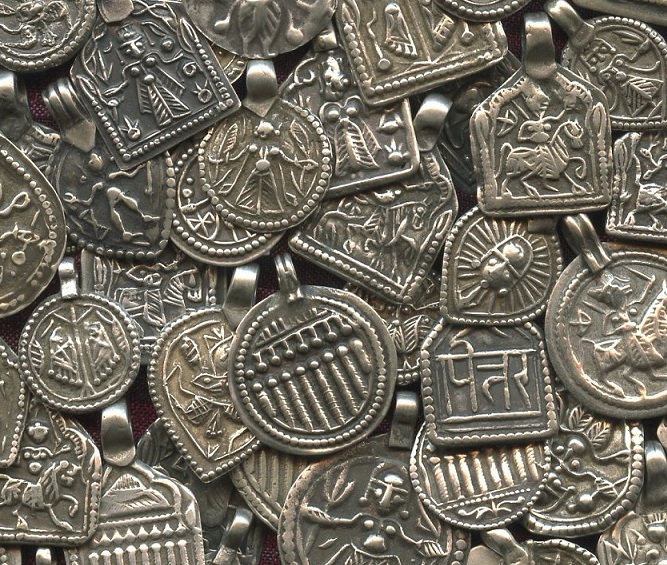Old & Ancient Beads
Please contact us for current availability
Beads have played an integral part in the lives of humans since primitive times. Not only were beads the first form of jewelry and body decor, they were also essential in commerce and used as currency around the world for millennia. In fact, the oldest beads are believed to be perforated snail shells from Morocco, with scientists approximating the age at 150,000 years! You won't find beads that old here, but you will find a variety of treasures dating back as far as 2000-4000BC. This page is informational and may not reflect what we currently have available. Please contact us for current available options.

Antique Tibetan Turquoise
Tibetans have always placed a high value on the power of stone beads, and Tibetan turquoise is one of the top prized stones. Local to the Himalayas, this turquoise is viewed by the Tibetans as a symbol for the sky. Traditionally, the larger the bead the more power it possessed, so Tibetan women spend their lifetimes trading up to a larger and more wonderfully colored and patterned stone beads for their personal necklaces. The first jewelry given to Tibetan children is always turquoise, which is believed to keep people from falling.
A conservative estimate of age for the Tibetan turquoise beads is 300-500 years, but considering that turquoise beads have been used throughout the region since at least 1000 B.C., some pieces can be older than 500 years.

Antique Corals
For hundreds of years coral has been harvested and collected by populations of peoples worldwide. Since the Mediterranean is now protected from coral harvesting, the contemporary coral we are familiar with is more than often dyed in order to mimic the beautiful natural colors of ancient corals. The corals shown above are 100% natural, showing the amazing color diversity in ancient corals that you just can't find in modernly harvested selections.

Antique African Amber
African amber rough is originally from the Baltic region. African amber beads are generally from the 19th century and were formed into consistent, specific shapes. As always, the larger the bead the more highly prized it was. In general, amber tends to need to be worn to absorb the natural oils on our skin. If you leave your amber unworn for an extended period of time it will start to dry up on the surface, so remember that the more attention you pay to your beads the more beautiful they will become!

Ancient Amazonite
Also known as green feldspar, amazonite beads have been sought after since ancient times because of their pleasing blue/green tones. Egyptians used this stone for thousands of years, as did many tribal African peoples. Most of these beads were rediscovered in Mauritania and Mali, but they have also been found in Indian and Egyptian digs. A very conservative estimate of the age of our amazonite is 2,000 years old, although some amazonite beads have been estimated to have been made in 4000 B.C.

Antique Ethiopian Coptic Crosses
Ethiopian Christian converts have been wearing crosses for more than 1600 years. The designs vary widely and indicate the town or province of origin. They are either lost wax cast or cut directly from a Maria Teresa (Marie Antoinette's mother) dollar. That coin has a higher silver content than most. The older the piece, the better the quality of silver. The simpler, plainer designs are the oldest showing Greek, Latin, Egyptian and even Celtic influence. The 19th century designs became much more elaborate due to a ready supply of silver.

Antique Ethiopian Telsum Amulets
Telsum, small silver triangles and half circle shaped amulets, come from Ethiopia. Though these are ancient designs, these pieces were made in the 1800-1900s. Granulated (covered with tiny balls of silver) or plain or sometimes worn smooth, they guard against the primitive fears of the evil eye and crescent moon. Traditionally, they're worn in long necklaces strung on brightly colored yarn that feature a mix of the shapes and their meanings.

Antique Hindu Deity Amulets
The majority of these pendants originate from the northwest Indian provinces of Rajasthan and Gujarat, but they are found throughout the entire subcontinent. Made of stamped coin silver (90%+ silver content), these pieces feature images of Hindu deities including Shiva, Hanuman, Durga, the footsteps of Vishnu and a few others. These pieces were made from the late 19th century to the early 20th century, making the newest pieces about 75 years old.

Antique Tibetan Amber
Tibetan amber has been traded into the region from the Baltic for more than 2,000 years. Like African amber beads, the larger the amber bead the more highly prized it was. However, unlike the African amber, Tibetans didn't want to waste any of the precious substance, so instead of carving the amber into shapes they just drilled holes in the natural lumps and polished them, preserving some of the original shape. For that reason, Tibetan amber tends to have a more "organic" look than African amber. In Tibetan culture amber is represents the earth.




